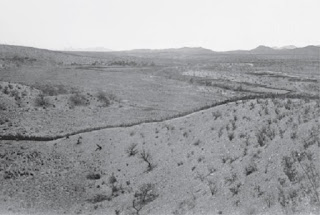The little town of Pantano (originally a stagecoach stop) has since disappeared into the desert, but was moved at one point due to the flooding that occurred during monsoon season. It's hard to believe it got it's name from the Spanish word for Marsh.
Right where I live, it becomes Pantano Wash, dry most of the year. I was wondering where all the critters come from that greet me at the water hole, so I took a walk down to the wash. Okay, I actually drove most of the way with my AC on high since the weather insists on staying in the 105 region.
Wasn't I surprised to find a trailhead, right in my own back yard. I was also surprised to see just how big Pantano Wash really is. It's all protected as part of the Las Cienegas National Conservation Area and unfortunately requires a pass if you wish to go for a walk. That was rather disheartening. I was really looking forward to checking out the bridge area for my deer buddies.
Yes, I broke the rules and walked a few yards in so I could take pictures. I bet Miss Bobcat has a nice spot in the shade amid the cottonwood and willow trees.
That's when I found these tracks. It's hard to tell if they are javelina or deer, since they are very similar. Your guess is as good as mine, but I think deer.
Here's a picture of the creek from the 1880's. Notice the lack of scrub brush and trees. They say all the brush and cactus is a result of the huge numbers of cattle eating and depositing seeds across the country. It's hard to deny when you see images like this one.
Yup ... it is a trickle of water rather than a raging river. Occasionally too much rain did become a problem further downstream by my location, so over the years, lots of metal and junk cars were dumped into the river to keep erosion to a minimum. Now there is a big project to REMOVE all said junk since it has become a bike-path park-like area as it go through Tucson.
If you keep your eyes open as you hike along, you just might find a spot like this where the Hohokam Indians ground corn in depressions in the rock. Don't try this at home. I did it with my family's Indian grinding stones in grammar school. We made cornmeal with the delicate texture of sand and fried it up for our parents. It was awful!!
I would like to have gone further, but this big puddle kept me at bay. Yes I have 4-wheel drive, but didn't want to take any chances. I'm sure by now this has dried up completely in our convection oven temperatures.
I tried to find out what this critter was that I found wandering across the road. I've seen several of them in my back yard. I think it's a white desert snail. It's interesting how his foot is positioned. I know, photographers will take a picture of just about anything!!!!
So that's it, right in my very own back yard. Pantano Wash was not only the home of early settlers, but the temporary residence of many Indian tribes including the Hohokam and Chiricahua, to name a couple. I'm pretty sure they didn't hang around in the summer heat however.
With temps still hanging out at the 107 level, I won't be adventuring out much. I'm hoping the critters keep coming to me.








Thanks for the interesting tour around your back yard. So much fun history there in the southwest.
ReplyDeleteIt's a pretty cool place to live.
DeleteHe's probably one out of 200 Variety of snails and slugs 🐚🐌
ReplyDeleteShould've picked up a couple hundred more take them home and eat them👅
These snails were introduced to the cities of the Sonoran Desert from the Mediterranean region to control the Brown Garden Snails which were themselves introduced as a possible source for escargot. Does this remind you of the "Lady Who Swallowed a Fly"? These snails will also prey on slugs. They are common to abundant in gardens and damp lawns where they also eat dead leaves and occasionally young seedlings so their presence in huge numbers is not entirely benign.
During extended rain events these snails may emerge en masse from their usual hiding places seeking a drier location. Dilute rainwater, by osmosis, can drown these xerically adapted mollusks.
Wow ... that's interesting!! I had no idea!
DeleteWow. I was wondering about snails in the desert. Now I know. Good grief. Thanks, to Mister Ed.
ReplyDeleteI had no idea Judy!! How weird! Maybe I'll take some home to my slug city.
DeleteI think those Indians did a dance on your property before all the houses...a dance to have spiders and scorpions gather there all the time... And WHY do you have to register to do the walk? That sounds kinda strange.
ReplyDeleteApparently it's like a Federal Park ... you have to have a park permit in order to use the area. Really, I doubt anyone does that. I've never seen anyone that looks like a ranger.
DeleteWe spent years on Trust Land riding mountain bikes and never say anyone checking for permits. I've never seen a ranger anywhere on any state land. That is a nice looking snail shell.
ReplyDelete